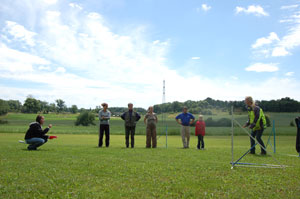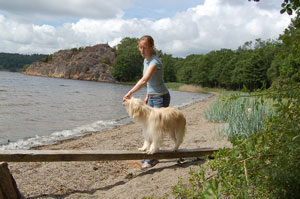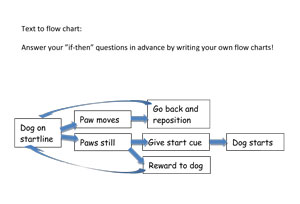Step by step
Successful dog training is really about you! In order to be able to train your dog in the best possible way you need to:
- Describe exactly what the dog should do
- Plan your dog's training (how is your dog going to learn to do the right thing?)
- Describe exactly what you are going to do when you train your dog
- Plan your own training (how are you going to learn to do the right thing?)
- Train yourself
- Train your dog

Typically, texts and discussions about agility training revolve around what to teach the dog (Running contacts? One-foot weaves? Collection on cue?) and how to best teach him that (where to begin, how to set up the exercise, how to progress, etc.). Often we seem to take the human part for granted, not paying attention to that side until we find that things don't work magically! You'll have a smoother ride by shining some light on the human part throughout the training process.
In this article we will assume you have already made the decisions regarding what and how you're going to teach your dog. We will take a look at the following steps, deciding exactly what you should do and how to go about planning and executing your own training. By honing the parts of the training process that are all about you (steps 3, 4, and 5 in the list above), you set the stage for your canine comrade and become a worthy coach.
Why is what I do so important?
After all, this is dog training, not people training, right? Well, it's the dog's behavior we are trying to alter when we train, but in order to change your dog's behavior, you first have to change your own. Training is never about directly altering the dog's behavior—training is about creating situations where your dog gets new experiences, so that he learns whatever it is you want him to learn.
Animal trainer guru Bob Bailey says that training is a mechanical skill. That's so true. In order for your dog to learn, you need to do the right thing at the right moment. There really isn't much difference between learning to hit a golf ball, paint a window, rock climb, and train a dog. Sure, dog training is complex and involves another living being, but it's still about doing the correct thing at the correct time.
When you have decided what it is you want your dog to do (step 1) and devised a plan for how your dog will learn to do this (step 2), the rest is all about you. You need to know your own job (step 3) and plan how you are going to go about teaching yourself to do the right thing (step 4). You then need to practice, so that you can manage to do the right thing at the right moment (step 5). There's really no point in getting your dog involved until this is done; that's when you have reached step 6.
How do I know what to do?
This requires taking a close look at the finer details of the training process—typically a second-by-second look. What does your job consist of?
Take, for example, wanting to teach your dog to wait and then start on cue from a start line. Your training plan might include giving the release cue if your dog keeps four feet still on the ground, and not giving the release cue if your dog moves. What then is your job exactly? You need to observe your dog closely, and utter or not utter the release cue depending on what your dog does.
Another example of your job could be to throw the ball over your dog's head as he focuses ahead. Picture working on your dog's finish, wanting to create a spurt for the finish line where your dog barges ahead at top speed, taking all the obstacles in front of him. The plan is that by throwing the ball ahead while your dog is aiming and running ahead, the behavior of "run ahead of me, taking all the obstacles toward the finish line" will be reinforced. In order to be successful with this goal, you need to be able to throw the ball where you want it to go. You also need to be able to time your throw so that the ball comes flying over your dog's head as he's aiming ahead (and not while he's running, looking at you).
One way to figure out what to do is to picture how "the perfect dog trainer" would act. Envision a brilliant trainer, either an imaginary one or an actual person who impresses and inspires you, teaching your dog whatever it is you want to teach him.
Another idea is a more organized flow plan. We often use flow charts to structure a training session. By thinking through and writing down the "if x, then y" scenarios that might occur, you'll be well prepared and you'll know what to do. Limiting your choices and making them clear in a flow chart will set you up for success.
Agility is a complex sport, with endless opportunities for improvement and new challenges around every corner. The more closely you analyze your job, the more details you get to, making sure that you know exactly what to do, the greater the chance is that you'll do the right thing. Doing the right thing will make it easier to teach your dog whatever it is you want to teach him.
To get help with this type of analysis, seek advice from instructors, training buddies, or the authors of various books and videos. This is an excellent path toward improvement of your own knowledge and skills! Just make sure the advice you receive regarding your own mechanics actually matches the training goals and training plan you have for your dog. Obviously, what you should do depends on your dog training plan, but sometimes this basic fact can get obstructed by well-meaning comments from people whose goals or methods may not match the ones you have chosen. So, do seek counsel, but keep your thinking cap on and stay in charge of your own training!
Use many senses!
Some people take in information best through their eyes. If you're a visual learner you'll benefit a lot from watching somebody else train the same thing, watching films, photos, and drawings. You might also want to read descriptions of what the desired behavior should look like, or use your inner eye to visualize the process.
Others take in information better through their ears. If you're an auditory learner, you learn well from listening. Ask someone to explain, listen to the narrator in the film, read out loud to yourself, and talk to yourself.
Yet others learn the best from feeling and doing. If you're a kinesthetic learner, you probably appreciate using models, or doing the exercise yourself. You might also benefit from "playing dog" to somebody demonstrating what it is you want to achieve, or being physically guided into the correct performance. Rehearsing the motions on the spot or in your mind is another helpful kinesthetic aid.
Dog training is a mechanical skill, so no matter which senses you utilize to get more information, you will then need to train yourself to physically perform the skills involved. But before you can do, you must plan.
How do I plan my own training?
Most agility handlers are painfully aware of the following: Knowing what to do and actually doing it, isn't necessarily the same thing! Use the same way of thinking when it comes to yourself as you do regarding your dog training—split your task into small parts so that you can work on one part at a time later. The smaller the parts you can identify, the easier it will be to do the right thing, and the faster your learning will progress. Of course, always focus on what you should do (instead of the opposite).
A good training plan for yourself, just as for your dog, needs to hold many small goals, a clever criteria plan (start out with small simple exercises that later will be built together and developed further), and a plan for how you'll know when you're on the right track.
How do I train myself as efficiently as possible?
The following check list will help you make your training efficient:
- Practice one thing at a time
- Give yourself clear instructions
- Make sure to get precise feedback that matches the instructions
- Use positive reinforcement, pinpointing what you do right
- Pay attention to your frame of mind—you should feel good and enjoy the training
You're not supposed to get everything right from the beginning! Focus on one detail and let go of the others for the time being, and then switch your focus and work on another detail. Learning will progress much faster if you allow yourself to work on one thing at a time. Work without your dog until you feel sure of your job; there is no point in getting the dog involved too soon. If a dog is needed to relate to for the skill you're working on, try using a human "dog." For example, involve your training buddies or your family. By working through your own skills first, and only involving the dog when you're reasonably sure you have your mechanics in order, your dog will be spared from a lot of rehearsing while you make mistakes.
Remember that it's completely normal for one behavior that used to work fine to fall apart when you add a new part to the behavior. Don't panic! Work on the new part, just noticing what's not working, and make a mental note about it. When you are done working on the new part, simply revisit the old part again until it's good again.
Let's say that you are working on perfecting your front cross. When you are working on your foot work, your timing might suddenly become off. This is not an issue. Stay with the foot work, adhering to the rule of practicing one thing at a time, and then revisit your timing skills. You might have to ping pong back and forth between the new behavior and the old one a couple of times before you can put them together and be great at both, but this, too, is normal and a good use of your time.
Clear as a click, and as positive as possible
Whether you're training on your own or with the help of others, clear instructions are very important. The best instructions are short and exact. By splitting what you are aiming to do into small parts, the instructions can be crystal-clear. Long talks and discussions have value at various times, but those times are not in the middle of practical work. Save the lengthy discussions for another occasion.
Learning will progress the fastest if the feedback that you give yourself matches the instructions. (Naturally, this is also true when training somebody else.) If the task you've given yourself is "Run straight ahead when your dog exits the tunnel," the feedback should be connected to that task. It's about focusing on one detail at a time; for the time being, daring to disregard other things. When you are practicing moving straight ahead, it really doesn't matter if you're flapping your arms or bending too much forward. What's important is whether you are moving straight ahead or not. If you have a well-meaning helper or instructor who gives you feedback on something that doesn't match your current focus, learn to store that feedback (perhaps write it down) for future reference. Put your own questions toward what you are actually working on. This prioritizing will propel your training forward faster than if you try to incorporate information about something that was beyond your focus at that moment.
Your brain is the most prepared for learning when you're relaxed and happy, so make sure to create positive training situations. Exercises that you can manage and that focus on what you have at hand will contribute to making training a positive experience.
TAGteach

Role-playing with an imaginary dog.
The helper and handler practice.
An outstanding method for training yourself and/or others is TAGteach, Teaching with Acoustical Guidance. It's basically the same as clicker training, but for people. What's different from clicker training is the opportunity to talk about the training.
Typical of TAGteach is:
- Focus on the behavior
- Tag points (criteria)
- The use of a marker, for example a clicker
- "Tag talk"—in order to facilitate training, everything is phrased in the positive
With TAGteach, instructions and feedback are crystal-clear, focus is on one detail at a time, and all feedback is positive. Clear and concrete instructions are given in the shape of tag points (for example "The tag point is toy in your left hand"). When you do it right, you immediately receive positive feedback in the shape of a click.
A tag point should always be an isolated, easily observable behavior that can be noticed and tagged (marked). You receive immediate feedback every time you meet the tag point. Just as in dog training, the clicker provides better timing and binary information, way beyond what is possible with words. If you are training in a group, take turns tagging each other. If you are training yourself, you'll have to focus on the tag point and note to yourself when you have met your criterion.

The dog gets to play
once the handler is well-prepared.
With TAGteach, the difference from clicker training lies mostly in possibilities given by the use of language. Humans can reason about training, and you should make use of that ability. Make sure to express yourself as clearly and positively as possible. Talk about what you should do, not what you should not do, and stay away from phrases such as "That was better, but…" In order to help your focus, the tag point should be the last thing you hear before you begin an exercise.
A teacher for two
Part of what makes dog training so fascinating is that it involves two constantly learning organisms—one human, one canine. By engaging yourself as your own coach you will make the training process more streamlined, more efficient, and more enjoyable for you both.
Good luck with your training! Your dog is the winner here, because when you get it right his job is simple. Happy training!



Post new comment